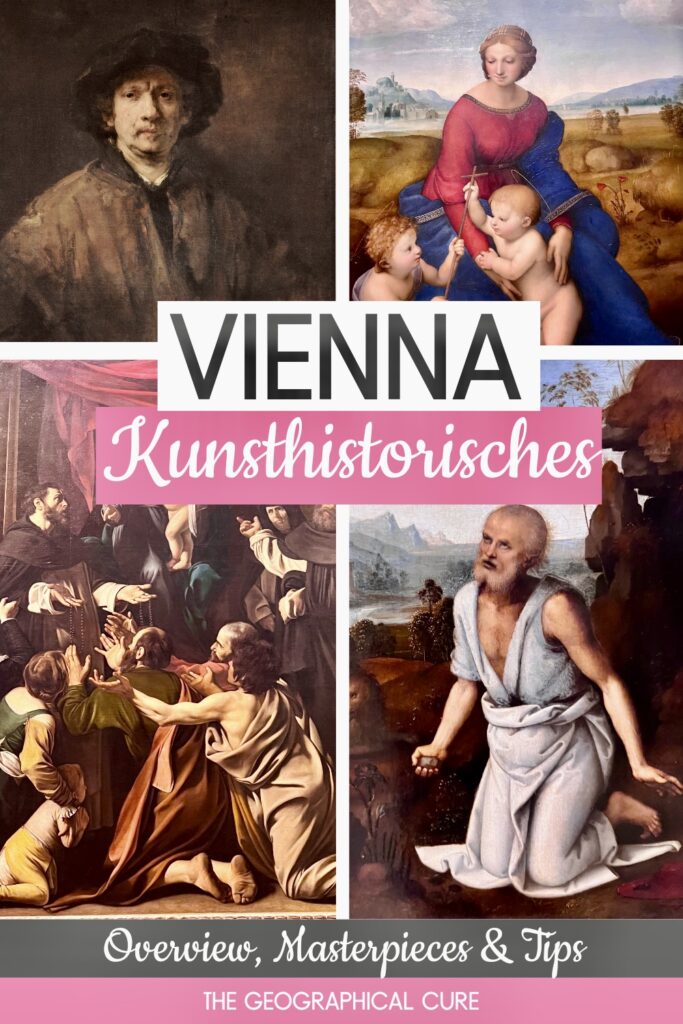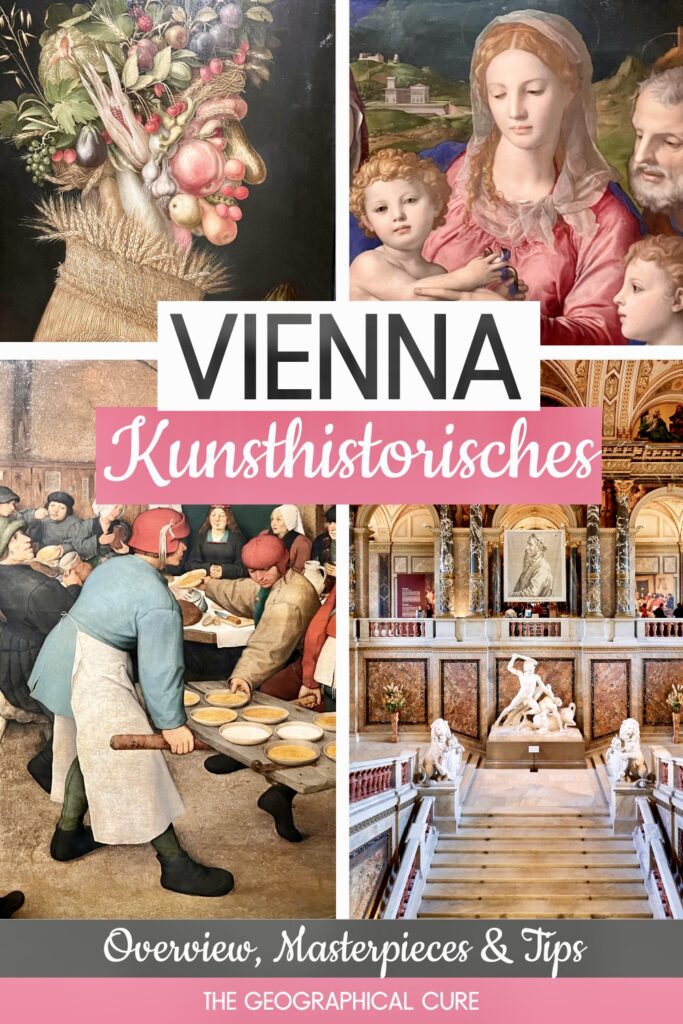Ths Kunsthistoriches is the best museum in Vienna, in a sea of riches. It’s a world class institution housing the art and artifacts of the imperial Hapsburg dynasty.
The museum is a haven for art enthusiasts, history buffs, and travelers who want to enjoy a treasure trove of old master paintings, antiquities, and architectural splendor. There are artworks of Italian Renaissance painting, 17th century Flemish painting, and German Renaissance painting.
In this guide to the Kunsthistorisches, I give you an overview of the museum, identify and describe must-see masterpieces, and provide insider tips to ensure you have an amazing visit.
>>> Click here to pre-book a skip the line ticket
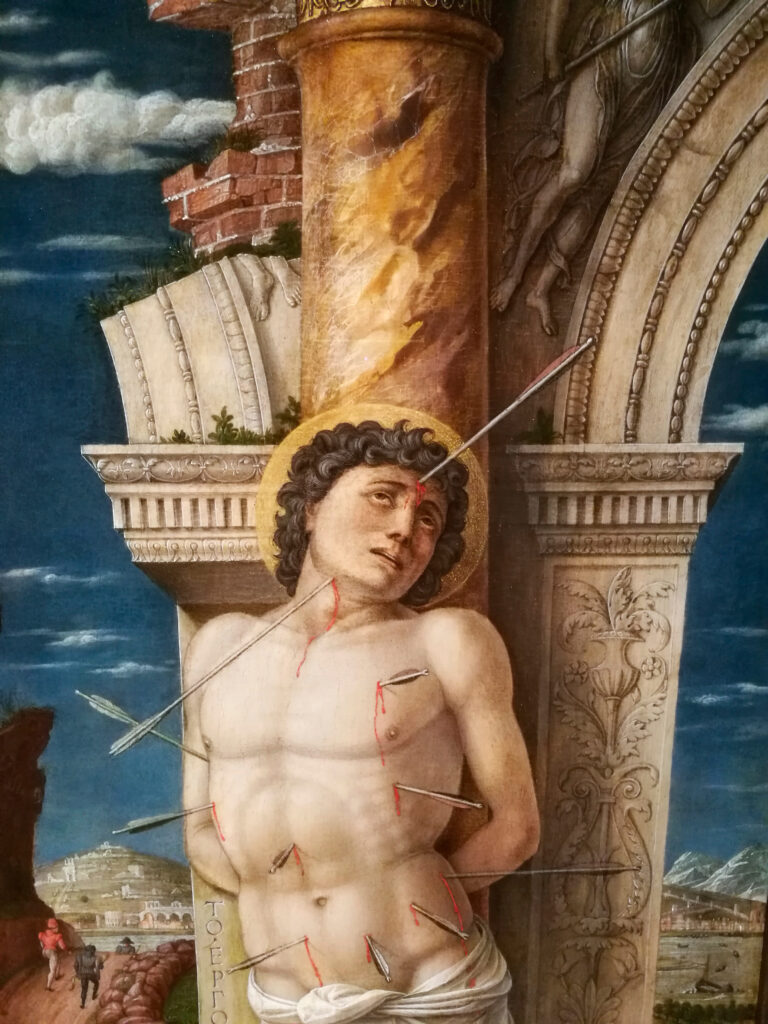
Overview Of The Kunsthistorisches
The Kunsthistorisches is housed in one of Vienna’s most beautiful buildings. It was completed and opened in 1891.
The museum has a grand neoclassical facade with a central dome, 4 smaller cupolas, intricate sculptures, and ornate details. It’s a twin of the Natural History Museum across Maria Therese square.
The museum has a 100 rooms spread out over three floors. Lavish marble, murals, and gold leaf adorn the entrance and halls.
On the ground floor, you’ll find three collections — the Antiquities Collection, the Egyptian and Near Eastern Collection, and the Kunstkammer (curiosities cabinet). On the first floor is the magnificent picture gallery, the museum’s top attraction.
The top floor houses the Coin Collection and the the Rubens Lounge. (Neither were open when I was last there.)
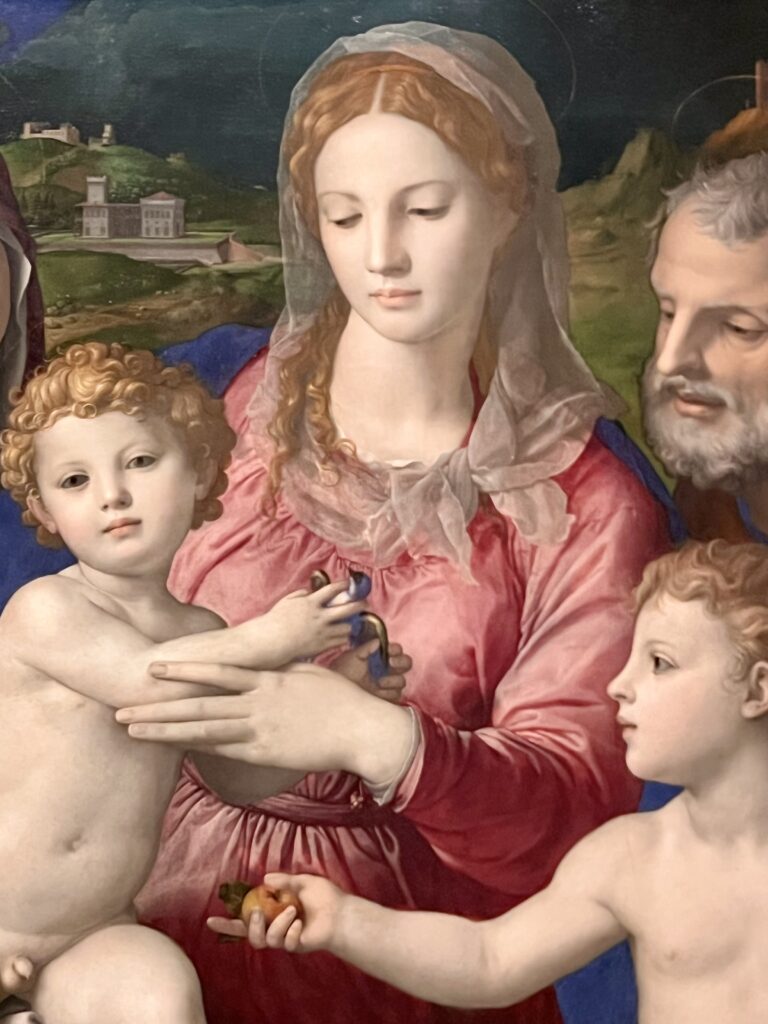
The picture gallery is a stunner. You access it via a magnificent grand staircase. As you ascend, you’ll see the massive Theseus Defeats Centaur sculpture by Antonio Canova.
The picture gallery specializes in Old Masters from the 15th to 18th centuries. One side has German and Dutch paintings. The other has Italian, Spanish, and French classics.
You can admire masterpieces by artistic luminaries such as Rubens, Titian, Rembrandt, Holbein, Dürer, Caravaggio, and Raphael. The museum also boasts the world’s largest collection of paintings by Pieter Bruegel the Elder.
Unlike some museums, there are also comfy spots, lined in blue velvet, along the museum path. You can sit, admire the art, and rest your feet.
The entire Hapsburg art collection doesn’t fit in this one building. You’ll also find artworks and artifacts in the Imperial Treasury and the Neue Building at the Hofburg Palace. You can buy a combination ticket to the Kunsthistorisches and the Imperial Treasury, if you plan to visit both.
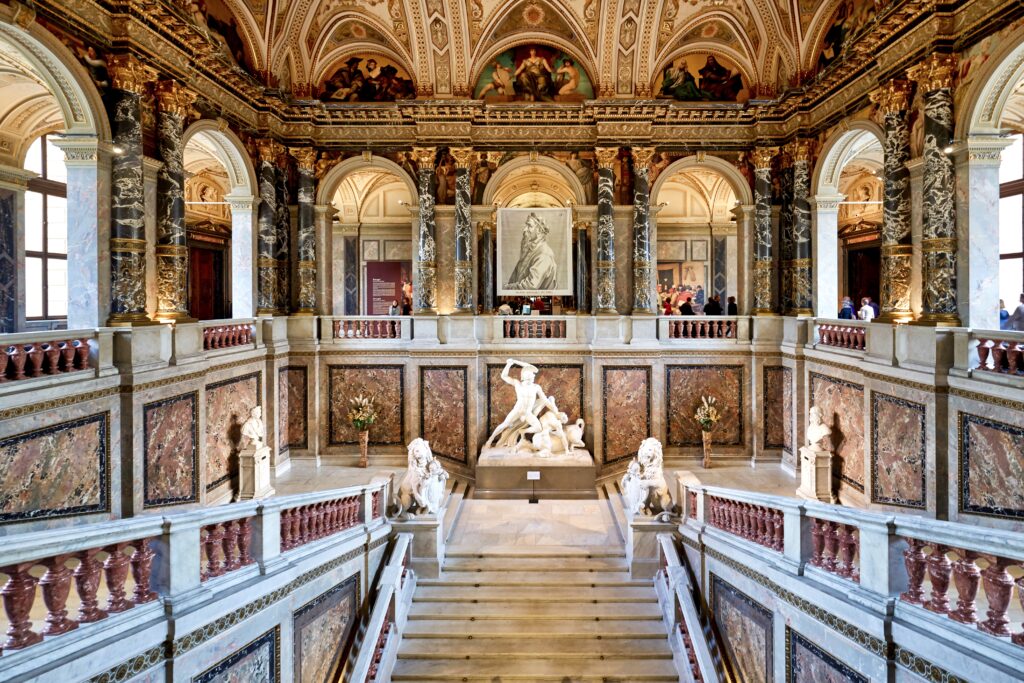
Guide To The Kunsthistorisches: What To See
Here are the top masterpieces and things you can’t miss at the Kunsthistorisches.
1. Munkacsy, Apotheosis of the Renaissance
This fresco is on the ceiling of the main staircase. It’s a fabulous trompe l’oeil work by the Hungarian painter Mihaly Munkacsy.
The fresco features the best and brightest of Renaissance art stars — Leonardo, Raphael, Veronese, Titian, and Michelangelo. They are presided over by a key Renaissance patron, Pope Julius II.
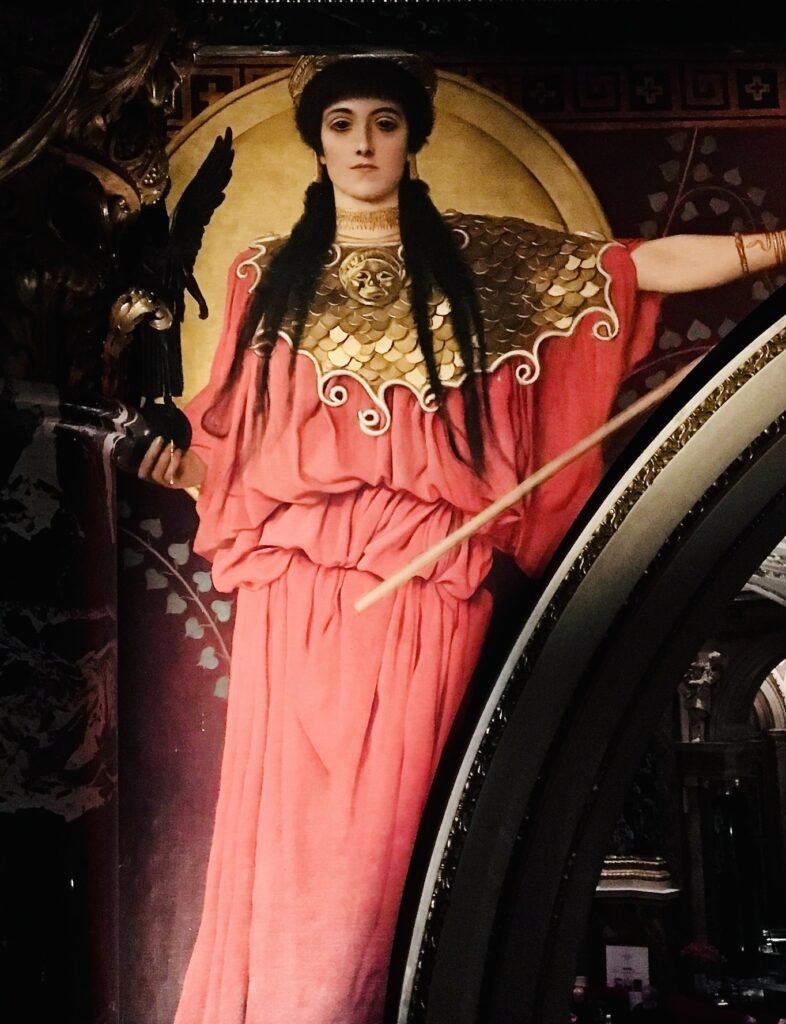
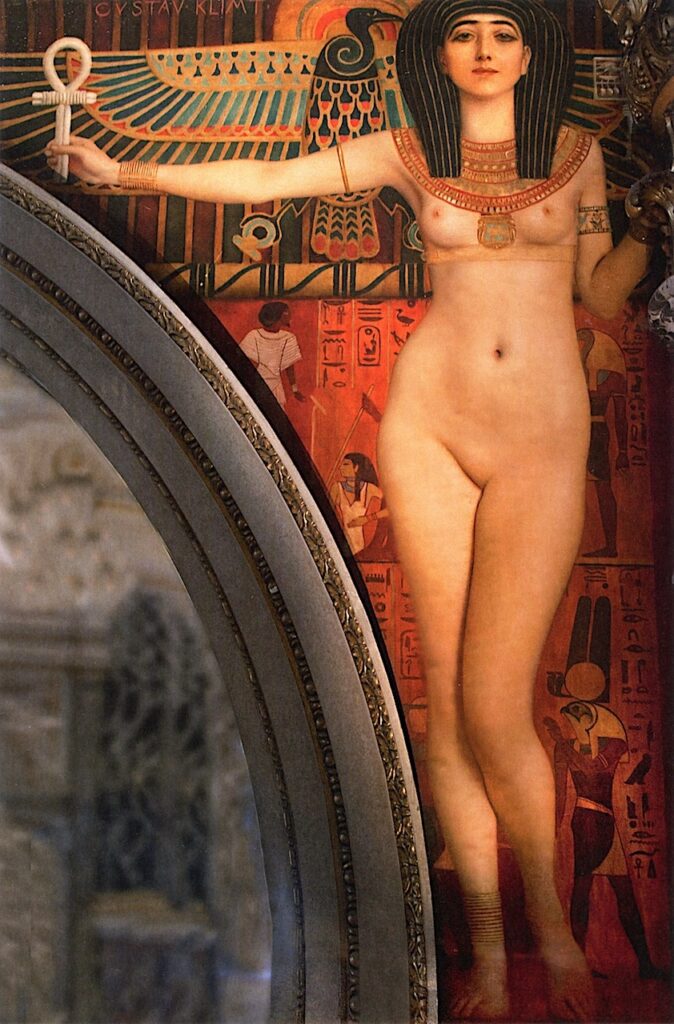
2. Klimt Paintings
Although most of Klimt’s most renowned art in Vienna is at the Belvedere Palace and Leopold Museum, you can find Klimt works on the sumptuous staircase between the arches and columns.
There are 40 spandrel paintings, 13 of them Klimt’s. Most people don’t even realize they are there!
This was an early and important commission for Klimt. These early paintings reveal Klimt’s artistic prowess. They depart from the strict historicism of the time in that the figures have human rather than god-like characteristics.
Every few years, the museum installs a bridge across the main staircase to allow visitors to see the paintings up close. The last time this happened was 2018, so hopefully it won’t be too much longer before a repeat.
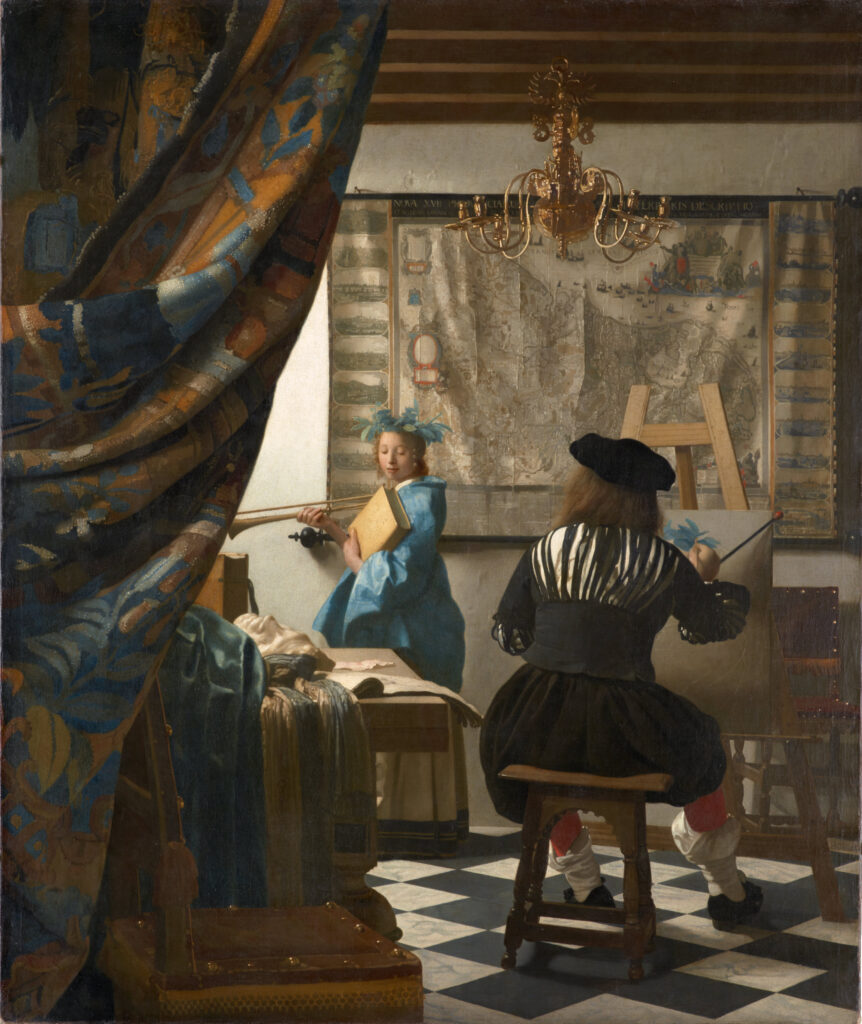
3. Johannes Vermeer, The Artist’s Studio
Johannes Vermeer was a Dutch Baroque painter known for his masterful use of light and color in his genre scenes. The Art of Painting is one of his most exquisite works.
The painting is an allegory on the art of painting and inspiration. It presents a richly decorated and spacious room filled with various objects and symbols. The artist includes an imaginative self-portrait at his easel.
His muse stands with a laurel wreath and is bathed in impeccably rendered light that streams through the window. The mask, treatise on painting, sketchbook, and detailed map of the Netherlands all suggest the importance of art in the course of history.
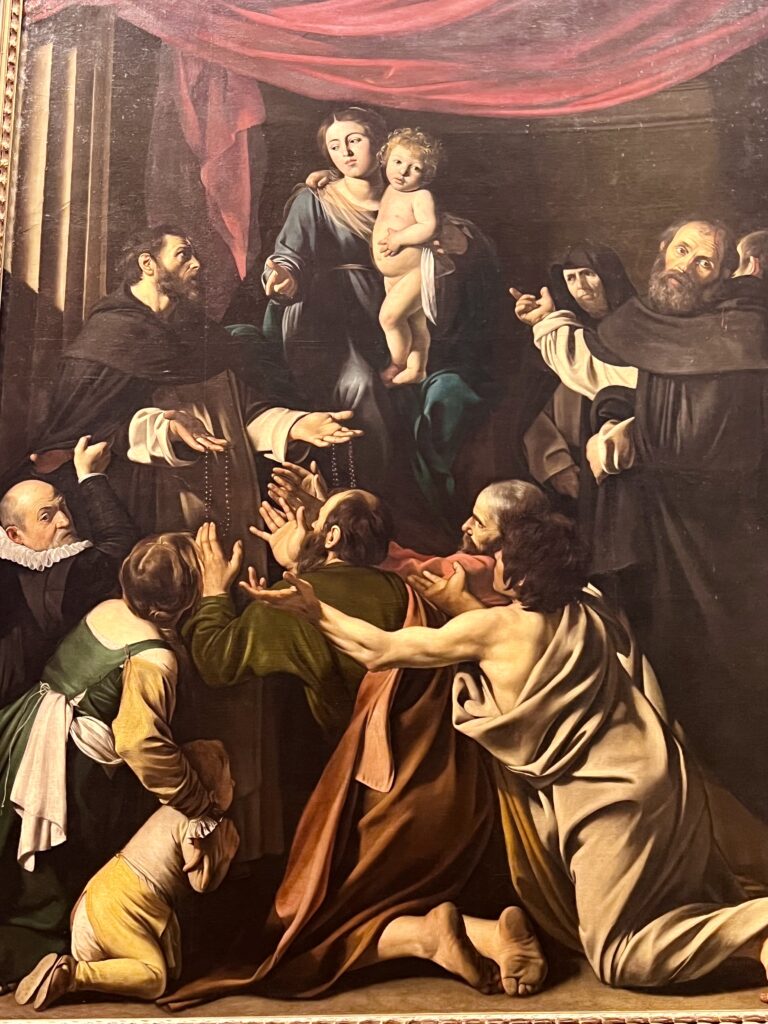
4. Caravaggio, Madonna of the Rosary
Caravaggio was the greatest painter of the Italian Baroque. He invented and used a darker, dramatically lit palette. He produced naturalistic and emotionally-charged works that were viewed as morbid, and bluntly realistic.
The Kunthistorisches owns several of his paintings, but Madonna of the Rosary is the largest and most impressive. It depicts the legend of St. Dominic receiving a rosary from Mary, which helped in his fight against the heathens.
The painting has Caravaggio’s trademark light-dark contrasts. The crowd presses in on the saint. They all want the rosary, but only St. Dominic sees the vision of the virgin.
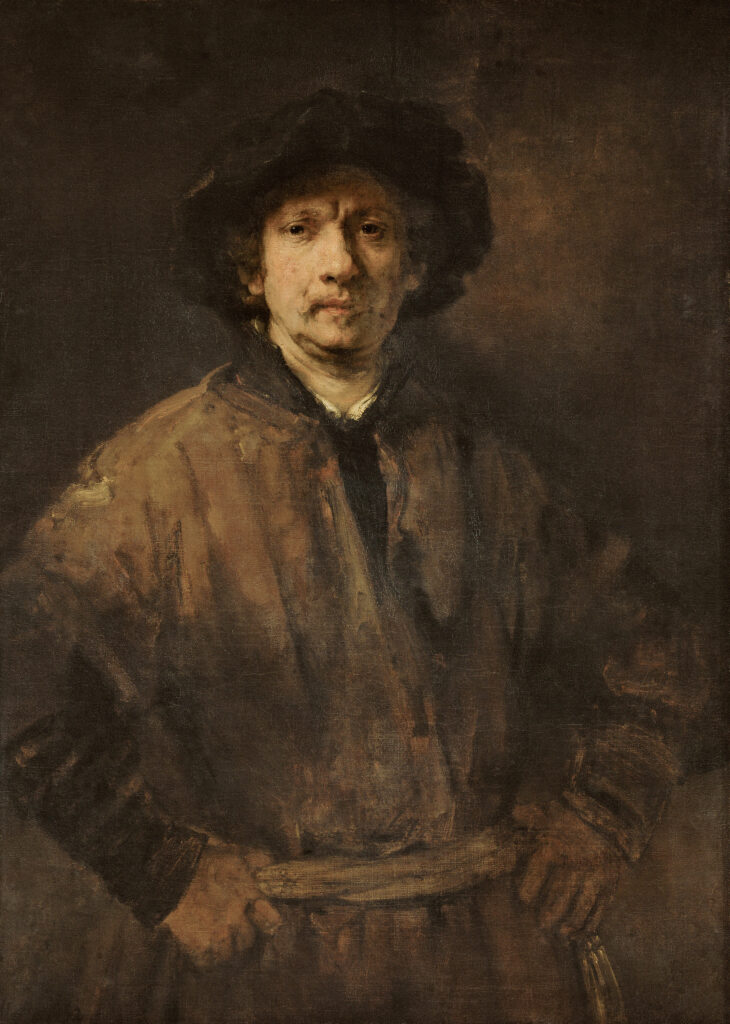
5. Rembrandt, Self-Portrait
Rembrandt was a Dutch Baroque painter and is usually regarded as the greatest artist of Holland’s “Golden Age.” He produced over 90 self-portraits throughout his career.
In this one, Rembrandt paints himself looking self-assured and scrutinizing. it was 4 years before his bankruptcy, so he wasn’t yet financially destitute.
The artist is no longer “disguised” as in other portraits. Instead, he wears a simple artist’s smock, the brown tones defining the color scheme.
The museum owns another, less important self-portrait and portraits of Rembrandt’s son and mother.
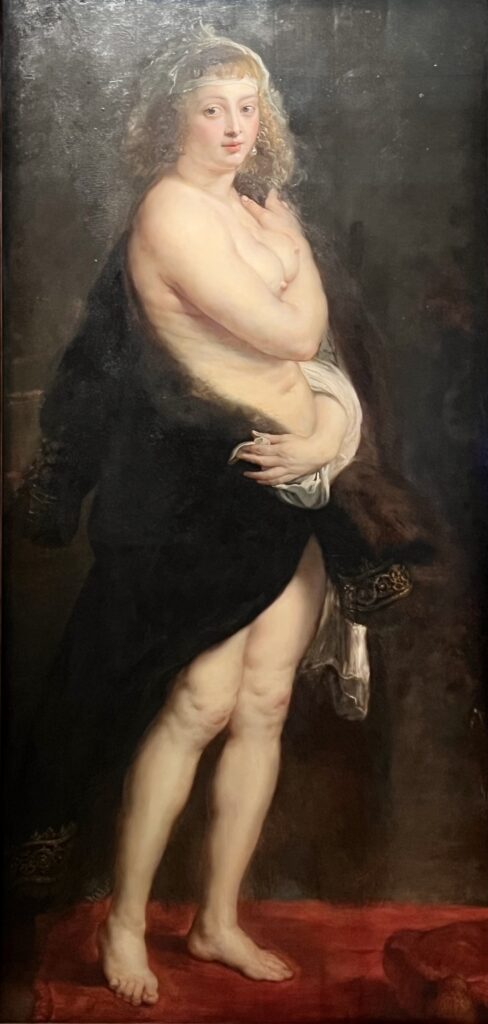
6. Peter Paul Rubens, The Fur
There are a plethora of Rubens paintings in the museum, truly. It was the first thing I saw when I stepped into the picture gallery. They were rather overwhelming in their size and quantity.
Rubens was an influential Flemish Baroque painter. He’s renowned for his masterful use of color, dramatic compositions, and his ability to convey emotion and movement in his artworks.
The Fur was my favorite Rubens painting at the Kunsthistorisches. It depicts Ruben’s second wife.
She stands, unaffected, with a fur wrapped around her. Rubens beautifully captures her glowing skin and expressive face, which contrasts with the voluminous dark fur.
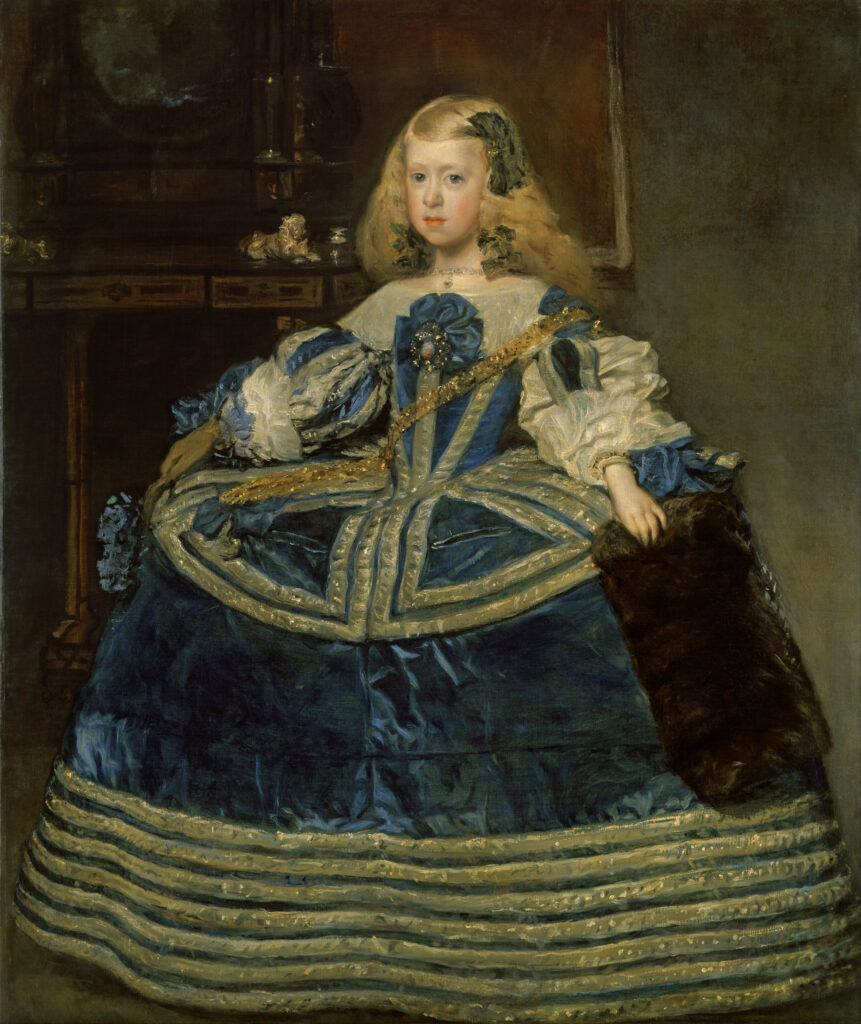
7. Diego Velasquez, Infanta Margarit Teresa at age 8 in a Blue Dress
Diego Velázquez was a renowned Spanish Baroque painter known for his masterful use of light and shadow, as well as his ability to capture the inner life and dignity of his subjects.
The Kunsthistorisches has of his three paintings of the Infanta Margarita Teresa. The one of her in a blue dress is the most famous.
Margarita was the daughter of King Philip IV of Spain. As a child, she was engaged to Emperor Leopold I.
The portraits were sent as gifts to the Austrian court. Velazquez displays his talents as a portraitist and has the impressive ability to grasp the soul of a child.
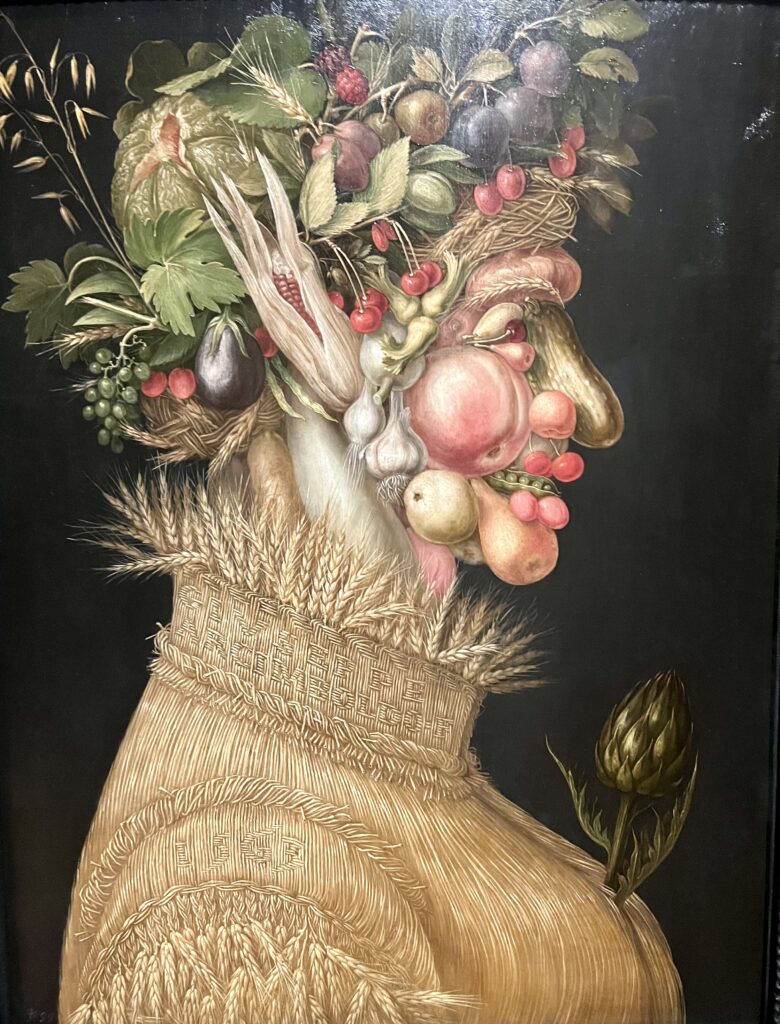
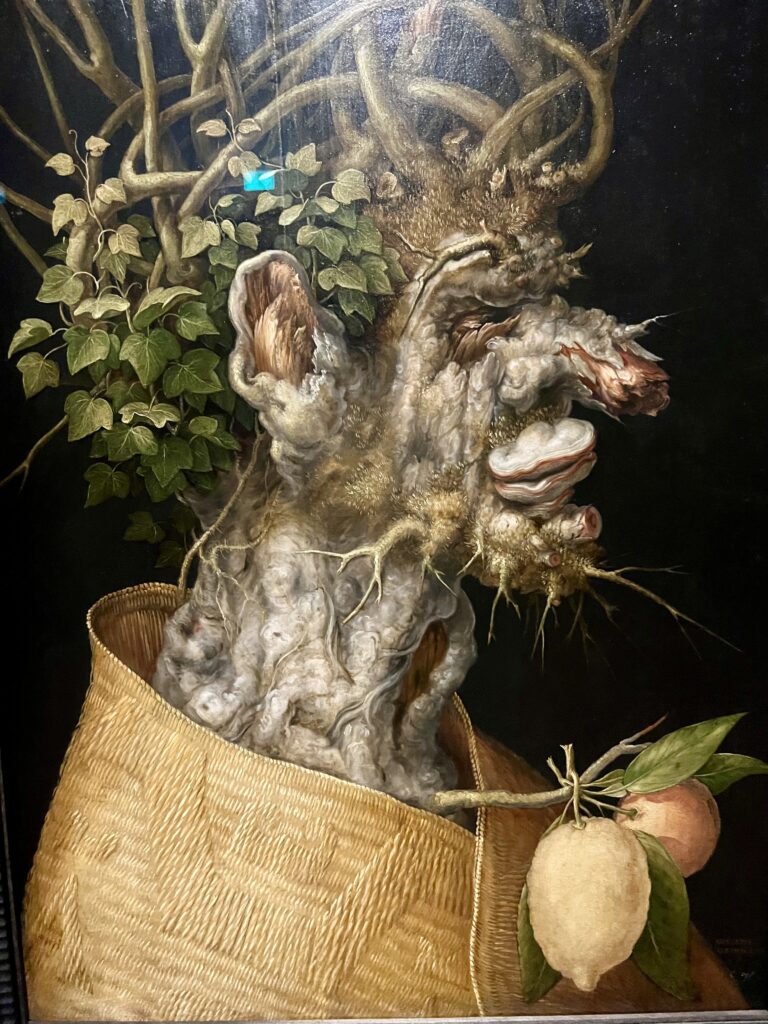
8. Giuseppe Arcimboldo, Four Seasons
Giuseppe Arcimboldo was an Italian Renaissance painter and imperial court designer in Vienna. He’s known for his imaginative and whimsical portraits composed of various objects, fruits, vegetables, and other elements.
One of his most famous series of paintings is the Four Seasons. In it, each season was depicted as a portrait. Only two of the originals survive, Summer and Winter. They are both in the museum.
Summer shows what appears to be the profile of a human face. But it’s composed entirely of fruit and vegetables. In Winter, the face is composed of a single tree and its parts, suggesting the coldness and bareness of the season.
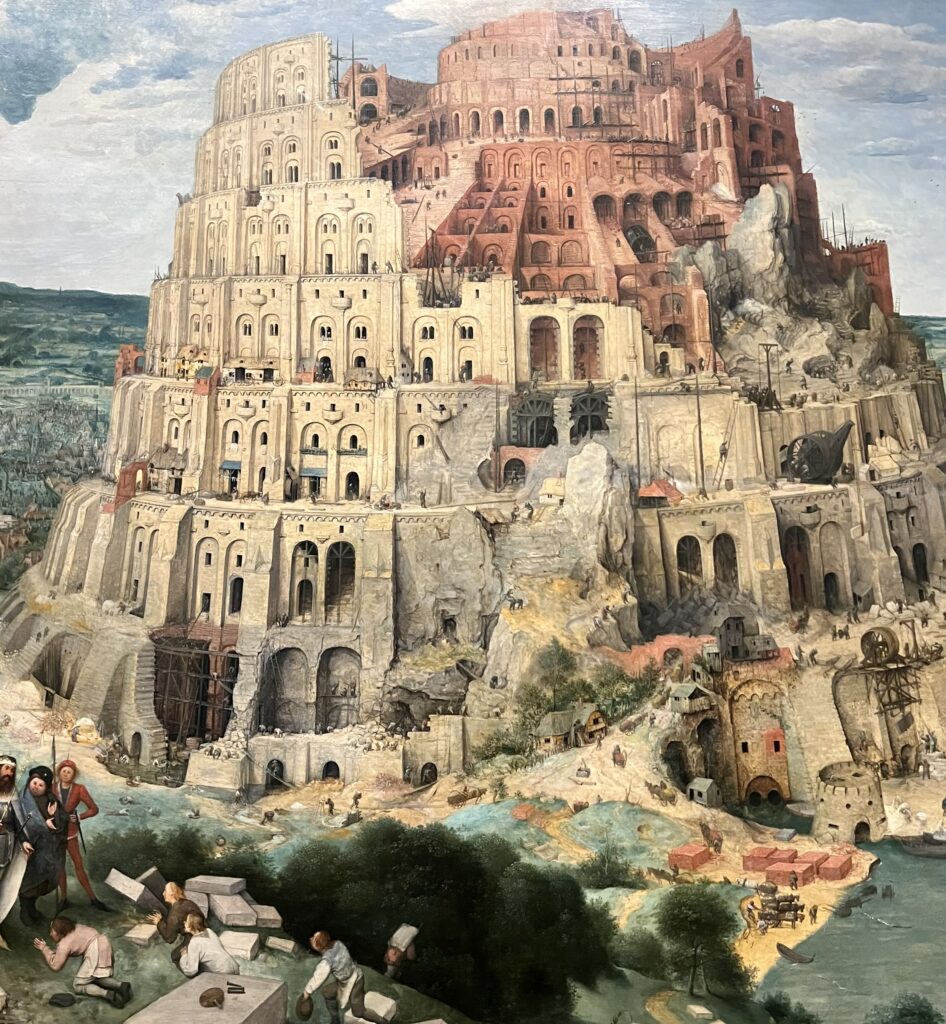
9. Pieter Bruegel the Elder, Tower of Babel
The large group of Bruegel paintings are a huge highlight of the Kunsthistorisches.
Bruegel is celebrated for his meticulously detailed works that offer commentary on the everyday life of 16th century Europe. His paintings are worldscapes — chaotic, comical, and sometimes even violent.
The Tower of Babel is one of his most iconic masterpieces and one of the museum’s most famous paintings. It depicts the Old Testament story of the construction of the Tower of Babel, a tale of human ambition and divine intervention.
The building is based on the Colosseum in Rome. There is no overt intimation that disaster is coming or that humanity will be punished for its hubris. Nonetheless, a close look at the structure shows that it’s liable to collapse.
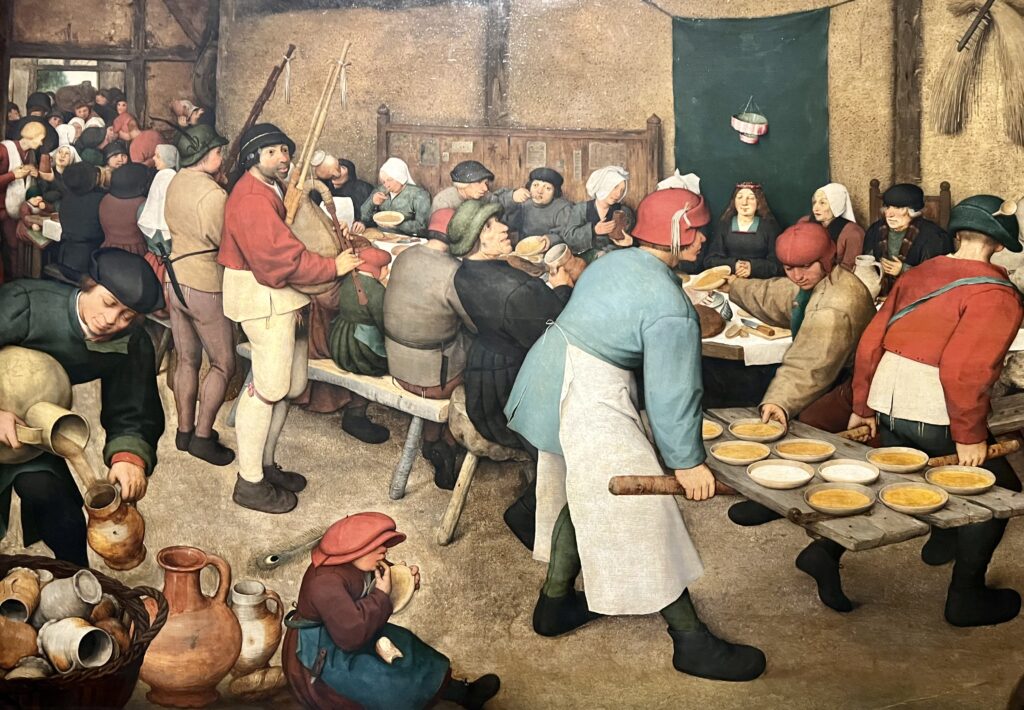
10. Pieter Bruegel the Elder, The Peasant’s Wedding
I love this Bruegel painting. It was one of his works that prompted that artist to be dubbed “Peasant Bruegel.”
This painting depicts a wedding banquet in a barn, with the guests feasting and drinking. The bride is almost an afterthought, a small figure sitting under a paper crown on the wall.
Bruegel seems to depict the peasants with dignity. And this painting is known as one of his most naturalist depictions of daily life.
Yet, it also seems intended to condemn gluttony — notice the cooking spoon in the lead waiter’s hat and the peacock feather (a symbol of vanity) in another man’s hat. Oddly, the waiter seems to have a third foot, a mysterious factoid that historian’s have long debated.
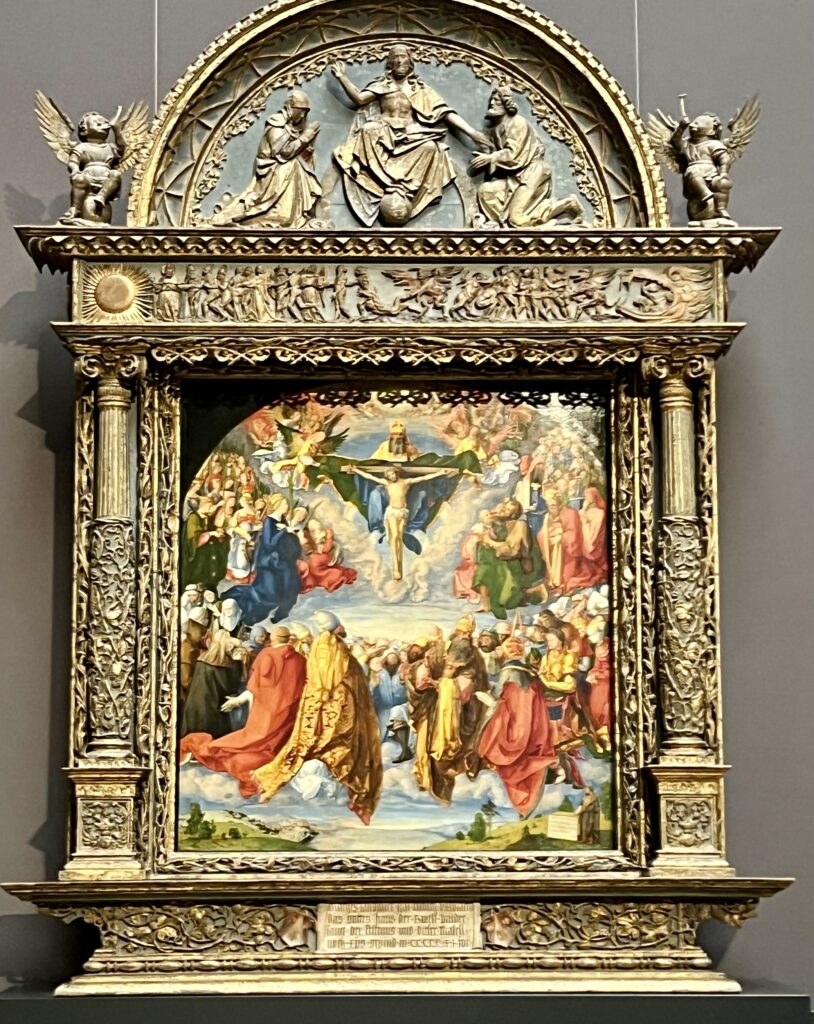
11. Durer, The Adoration of the Trinity
Albrecht Dürer was a versatile German Renaissance artist. He was known for his exceptional skills in printmaking, painting, and drawing.
His artworks show a commitment to meticulous detail and the exploration of mathematical and scientific principles.
This altarpiece was formerly in Nuremberg and was later in Emperor Rudolph II’s art cabinet. Christ is in the center with Mary to the left and St. John the Baptist to the right.
A Christian community is shown at the bottom. In the terrestrial world at the bottom, you’ll see a self-portrait of Durer himself. The artist was always aware of his self image and often added self-portraits to his paintings.
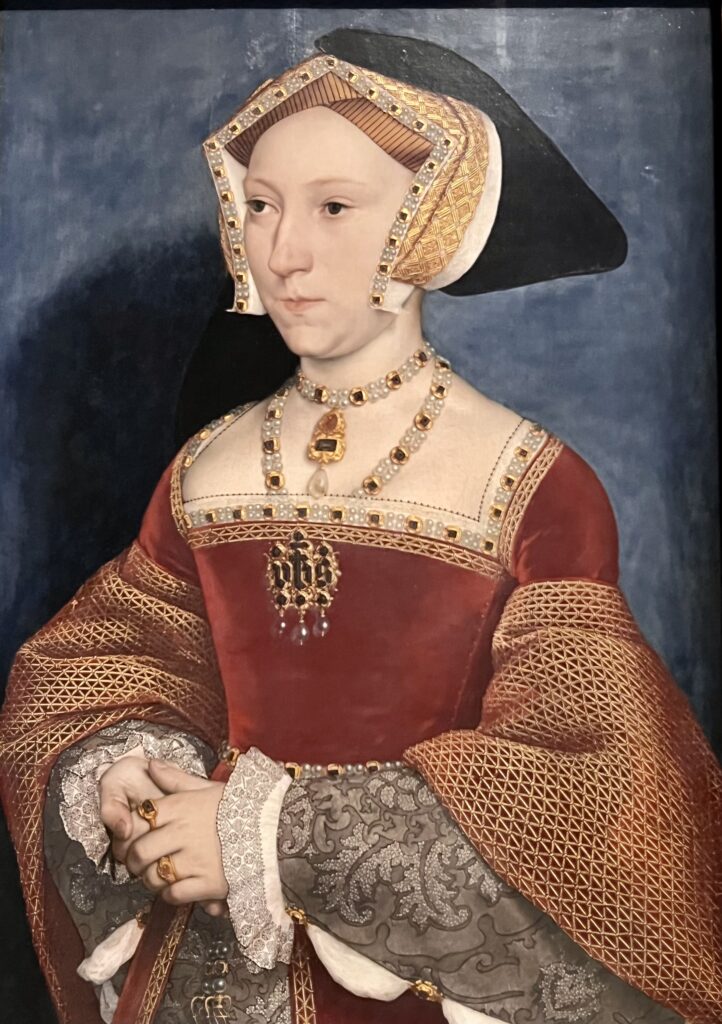
12. Holbein, Portrait of the English Queen Jane Seymour
Hans Holbein the Younger was a prominent Northern Renaissance artist known for his remarkable portrait paintings. In 1536, the artist joined the court of King Henry VIII of England.
After Anne Boleyn’s execution, Henry married her lady in waiting, Jane Seymour. He hired Holbein to paint her and this is the most famous image of the queen. She didn’t live long, dying after giving birth to Henry’s only son.
The museum owns quite a few other Holbeins as well, all of which originated in London.
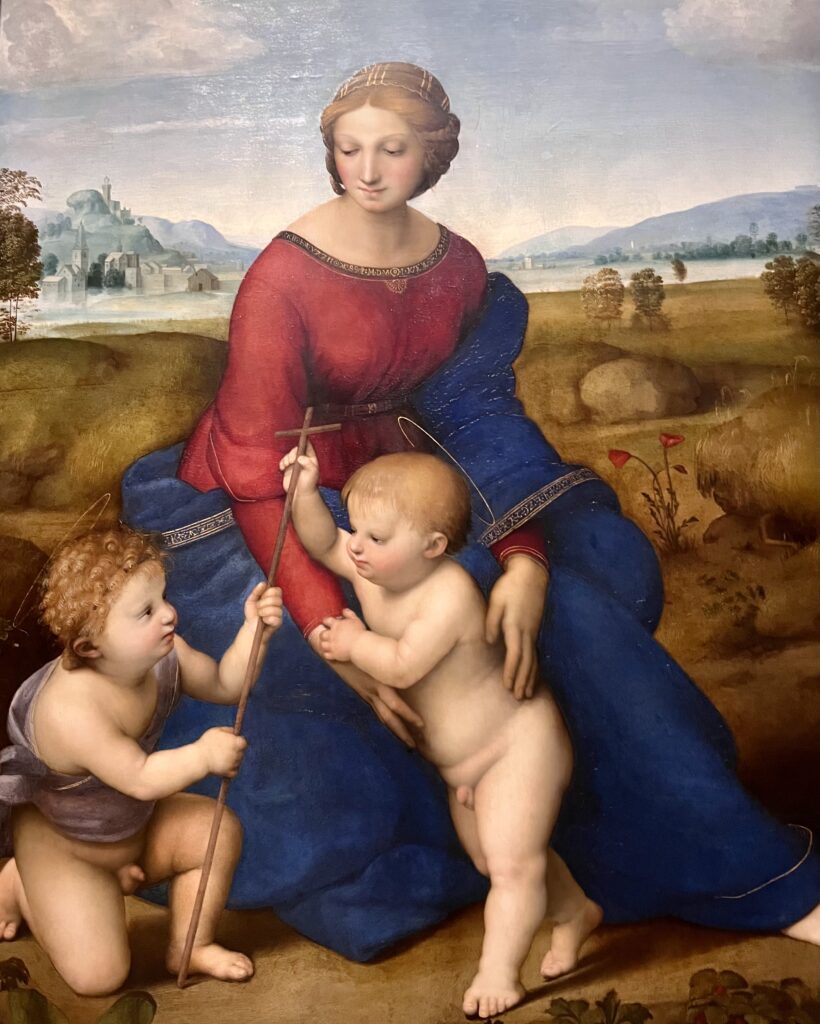
13. Raphael, Madonna in the Meadow
Along with Leonardo and Michelangelo, Raphael formed the divine trio of Italian Renaissance painting. His works were characterized by harmonious composition, idealized forms, and exquisite use of color and light.
The Kunsthistorisches owns the Madonna in the Meadow, a classic Madonna depiction. Raphael painted it during his 5 year sojourn in Florence, the Cradle of the Renaissance.
In the painting, Mary looks down lovingly at Christ and St. John the Baptist as they play. The trio are in a lively scene from the human world. But the blue toned landscape behind them suggests eternity.
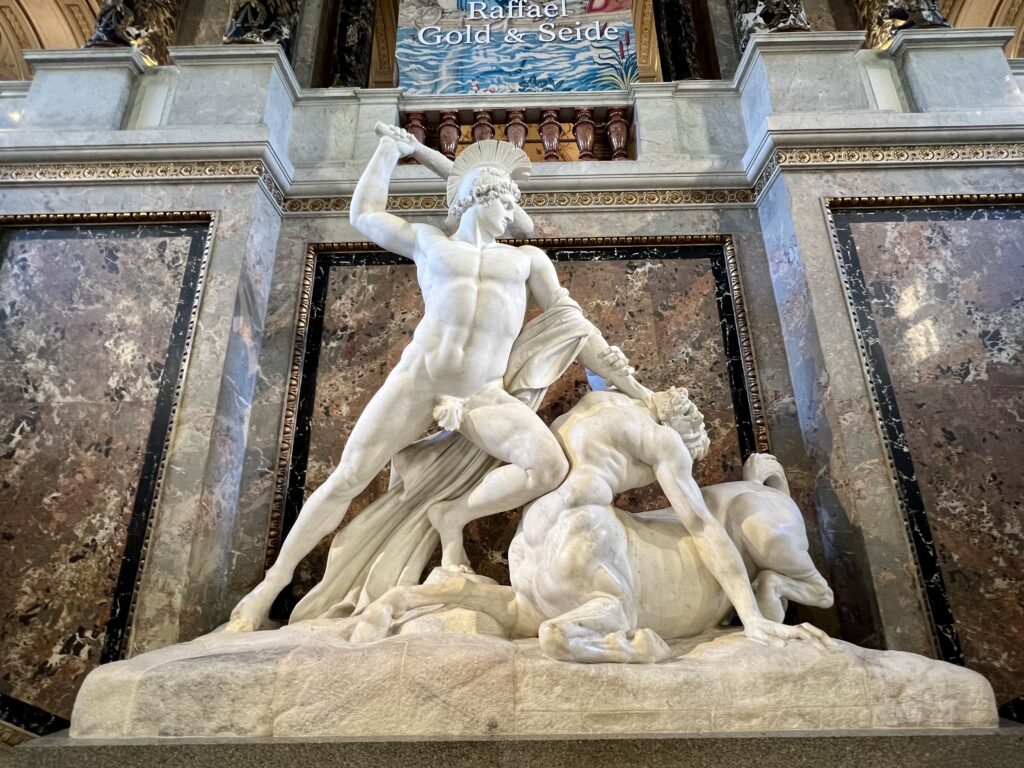
14. Antonio Canova, Theseus Defeats the Centaur
Antonio Canova was a renowned Italian Neoclassical sculptor celebrated for his masterful creations. They were characterized by graceful forms and meticulous attention to classical detail.
Theseus Defeats the Centaur is a neoclassical masterpiece created between 1804 and 1819. It has pride of place at the top of the grand staircase.
It depicts the Greek hero Theseus in a victorious struggle against the Minotaur, a mythical creature with the body of a man and the head of a bull. The theme is the triumph of human reason over brute strength.
Napoleon commissioned the sculpture for the Corso in Milan. Emperor Franz I scooped it up upon his defeat.
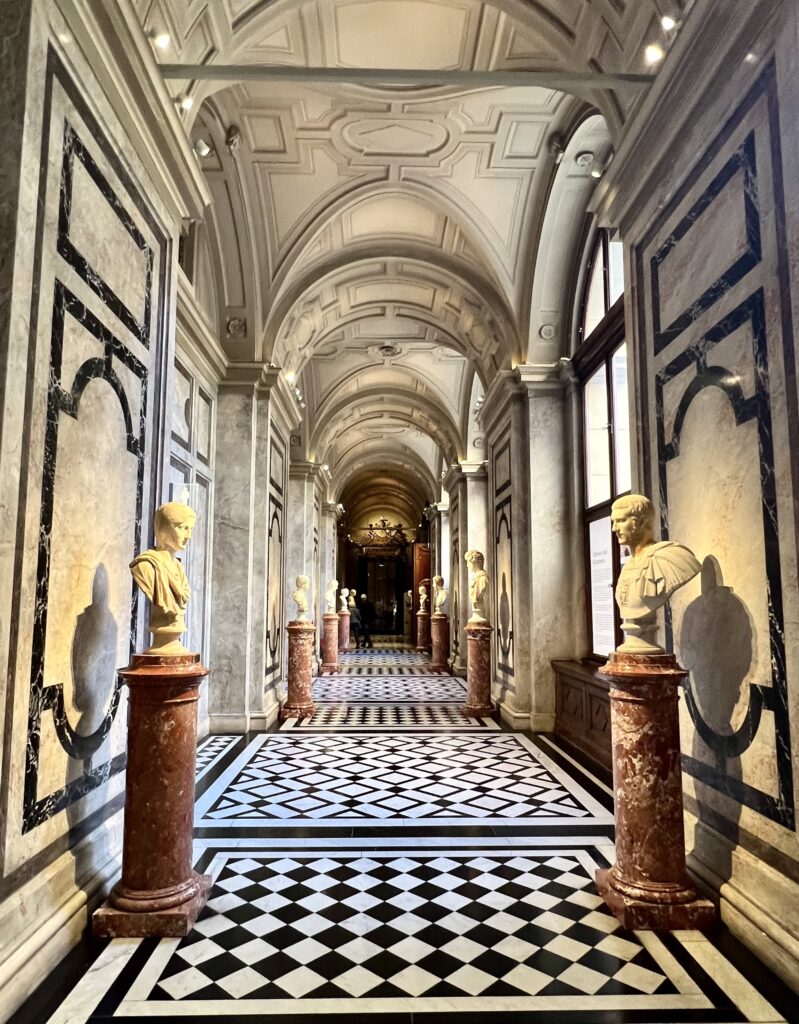
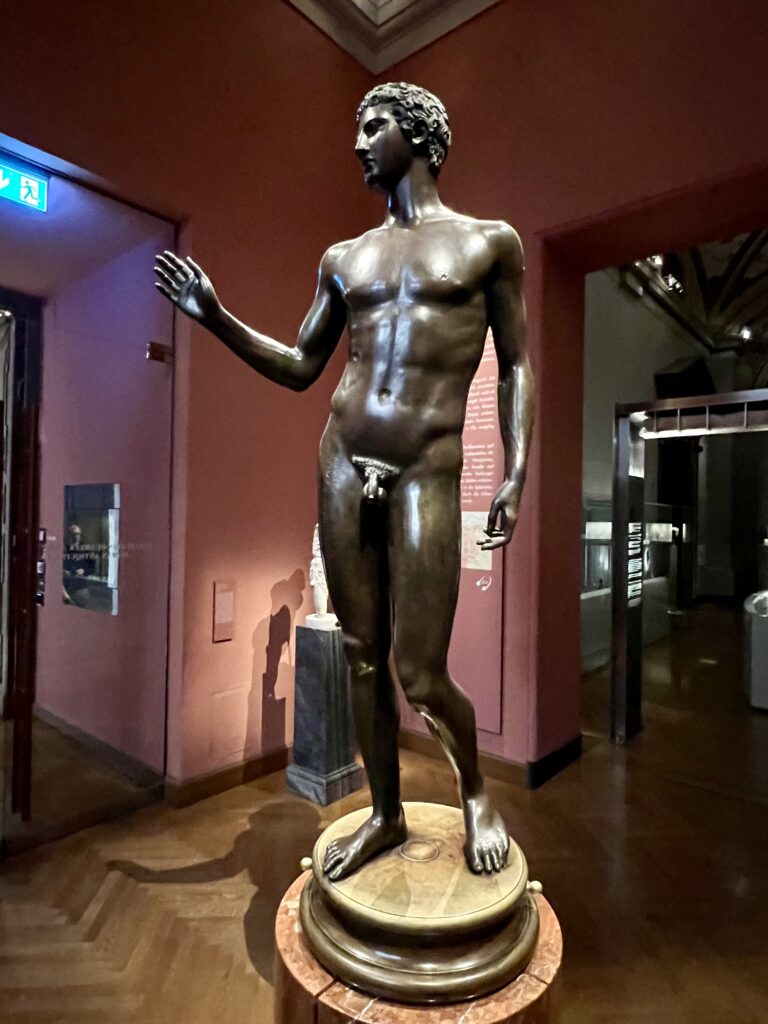
15. Antiquities Collection
As befitting a Renaissance court, the Hapsburgs began collecting antiquities in the 15th and 16th centuries. They’re shown off in beautiful galleries decorated with grotesque frescos on the ceilings.
They showcase an extensive collection of Greek and Roman antiquities, including sculptures, pottery, coins, vases, mosaics, and architectural fragments.
There’s a beautiful bust of Homer and Marcus Aurelius, and bronze sculptures of Hercules and Apollo. There is also a world beating display of antique gems and cameos.
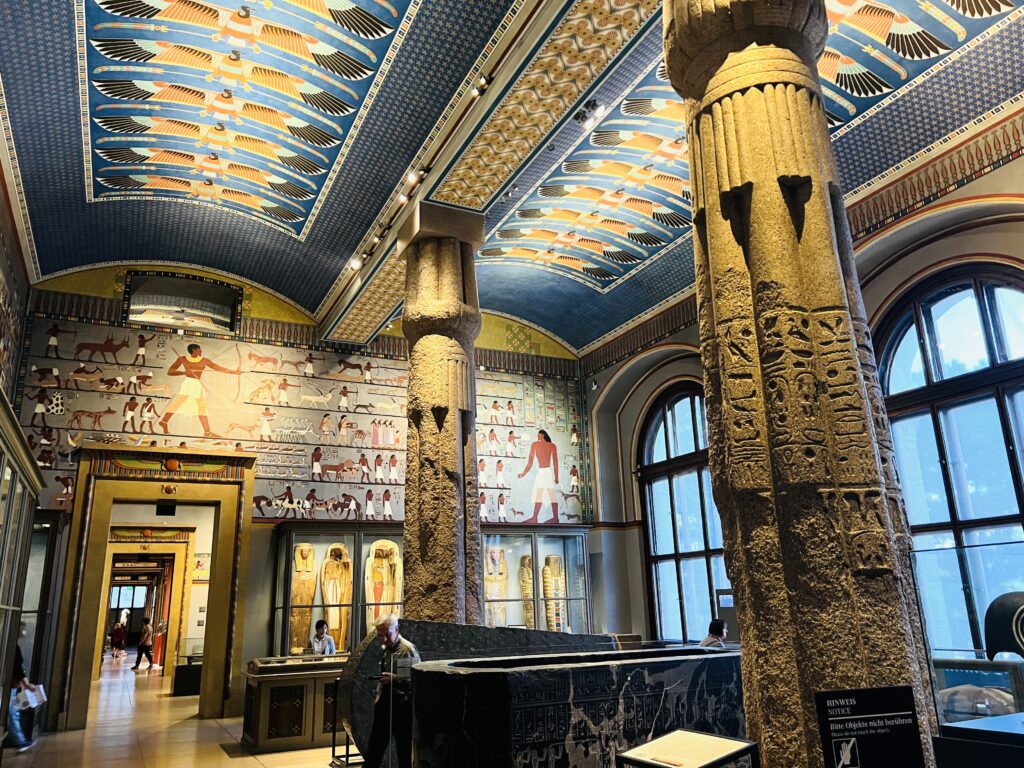
16. Egyptian and Near Eastern Collection
The halls that house the Egyptian Collection are simply stunning.
They are built and decorated in an Egyptian style. They house over 17,000 pieces from various eras, including the first and second dynasty.
The barrel vaulting is vibrantly painted and held up by pillars of rose granite. The walls are covered with paintings of the funeral chamber of a prince of the Middle Kingdom.
In this section, you’ll find Egyptian coffins, statues, statuettes, reliefs, and funeral steles. The star attraction, and mascot of the museum, is a blue hippopotamus from 2,000 B.C.
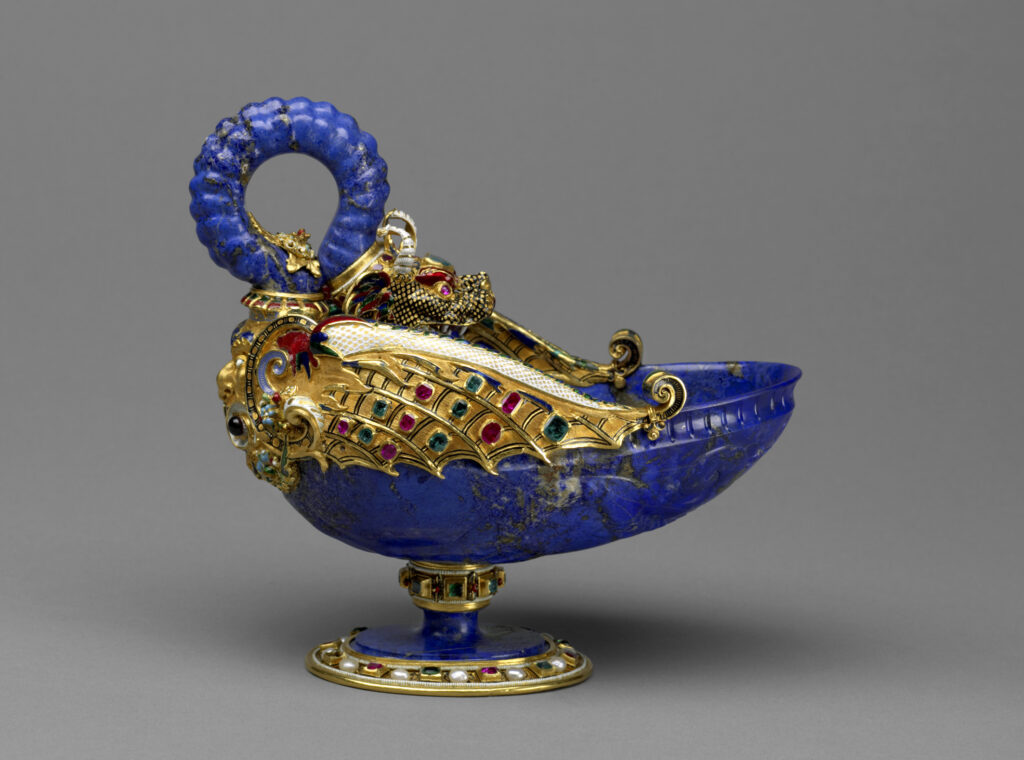
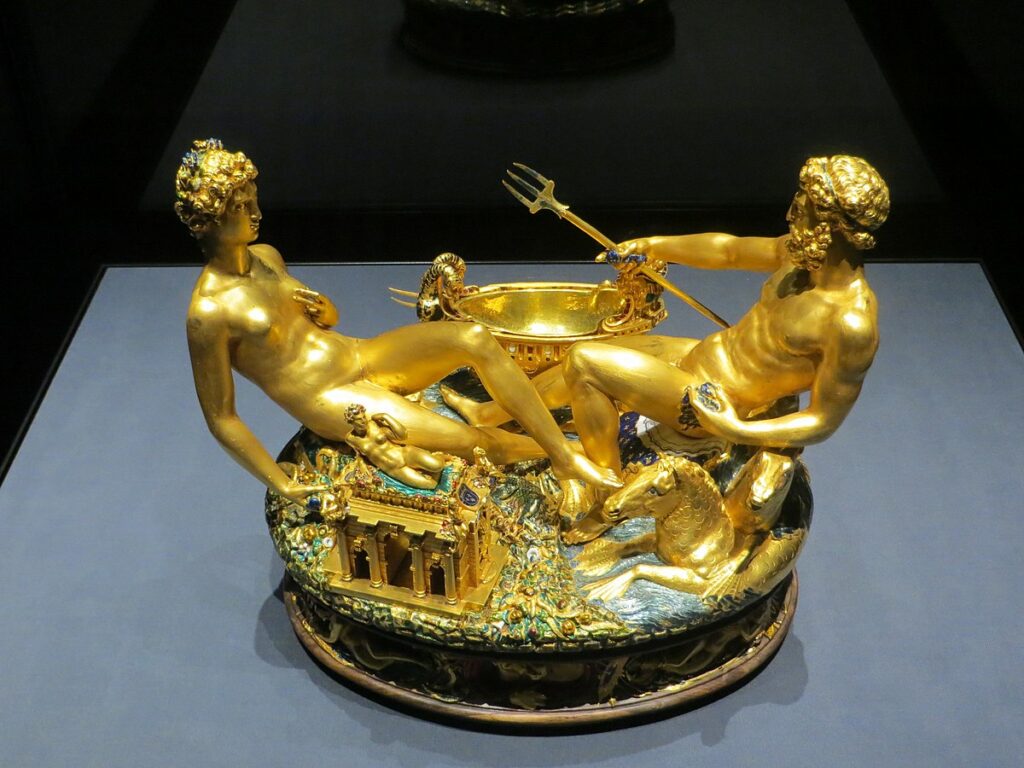
17. Kunstkammer
The Kunstkammer houses the Hapsburg’s sculpture and decorative arts collection. It’s essential a cabinet of curiosities, which includes the family’s most priceless objects and dynastic memorabilia.
There are a total of 20 rooms, displayed chronologically. In particular, there are quite a few objects of gold, ivory, and bronze.
Among the more interesting objects are a dragon bowl from Milan and a gold salt cellar created by Italian sculptor and goldsmith Benvenuto Cellini.
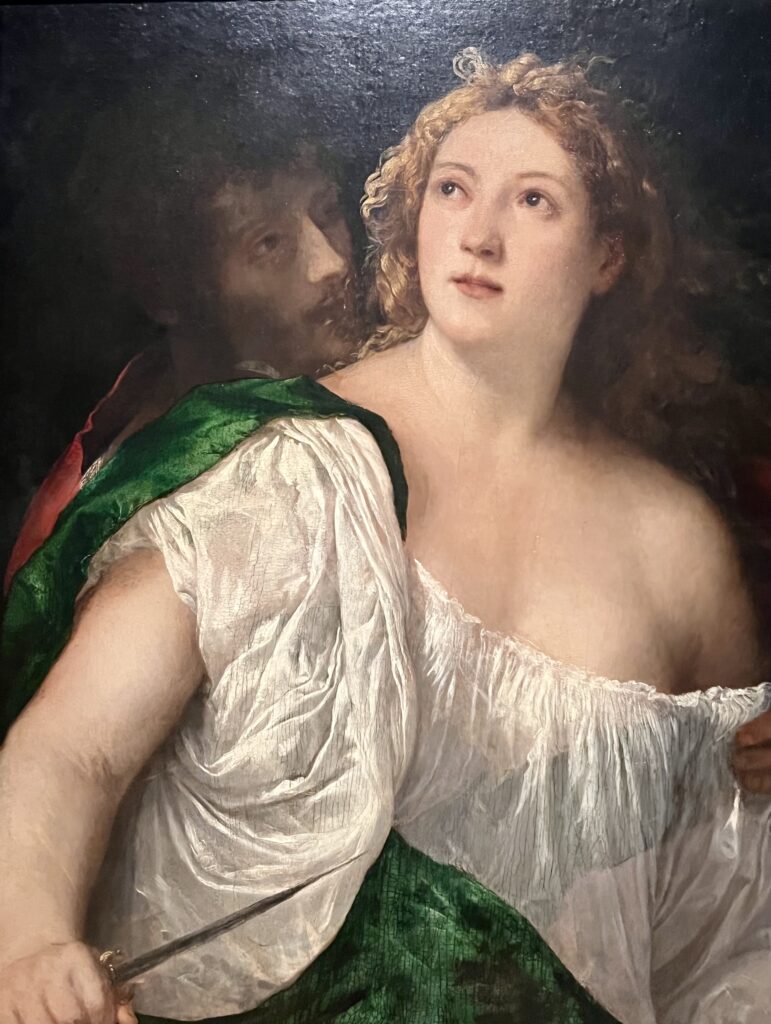
Practical Guide & Tips For Visiting The Kunsthistorisches
Address: Maria-Theresien-Platz, 1010 Wien, Austria
Hours: Open 10:00 am to 6:00 pm Tuesday through Sunday, closed Monday. On Thursday nights, the museum is open until 9:00 pm.
Tickets:
In high season, you’ll definitely want to pre-book skip the line tickets. The ticket is valid for the entire day, so you can break up your visit if you need.
In off season, you can buy tickets for 21 € either outside at the kiosk in front of the museum or inside at the automatic ticket machines. You cannot buy them inside the museum itself.
The audio guide is € 6 extra. There is very little signage in English on the ground floor, but there are informational plaques in the picture gallery and QR codes you can scan in places.
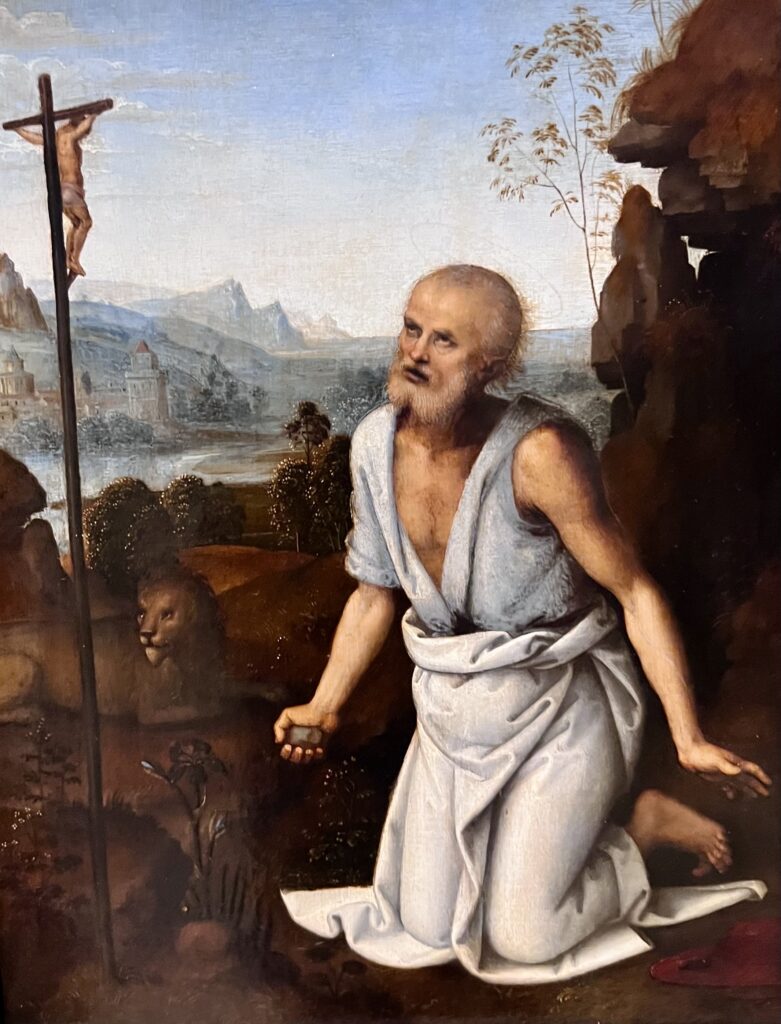
How Long To Spend:
As a conservative estimate, I suggest you budget 2-3 hours for the Kunhsitorisches. If you want to see everything and use the audio guides, it could take much longer. You could take a break at the museum cafe when museum fatigue sets in to regroup.
Baggage Check:
You can’t bring any large handbags or backpacks (of any size) into the museum. You’ll have to put them in one of the lockers in the basement. It costs one euro. Put the coin into the slot on the inside of the door, shut the door, and turn the key.
Guided Tours:
Because the Kunsthistorisches is so massive, I think it’s a fine idea to book a guided tour of the masterpieces. An expert guide can whisk you around and you can have a more efficient visit.
In July and August, the museum itself offers guided tours very Sunday from 3:00 to 4:00 pm for € 6 (excluding the entrance fee).
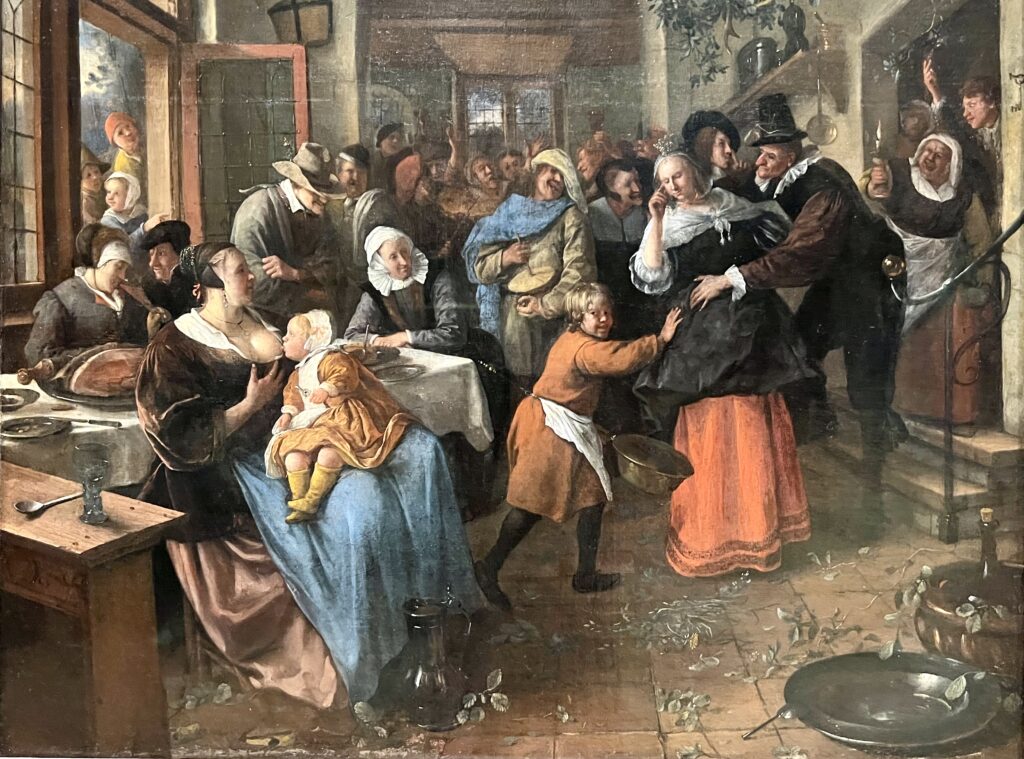
When To Go: I think the museum is busiest first thing in the morning when it opens at 10:00 am. So I’d avoid going then.
Shops: There are quite a few museum shops, including ones on the upper floor. If you have put your bag in a locker, you may want to bring a credit card with you.
Cafe: The cafe is in the palatial dome hall of the museum.
I hope you’ve enjoyed my guide to the Kunsthistorisches Museum. You may find these other Vienna travel guides useful:
- 3 days in Vienna itinerary
- guide to the Belvedere Palace
- guide to Klimt paintings in Vienna
- guide to the Beethoven trail in Vienna
- what to do in Vienna in winter
- best museums in Vienna
- guide to the Sisi Museum
If you want to visit the Kunsthistorisches, pin it for later.

